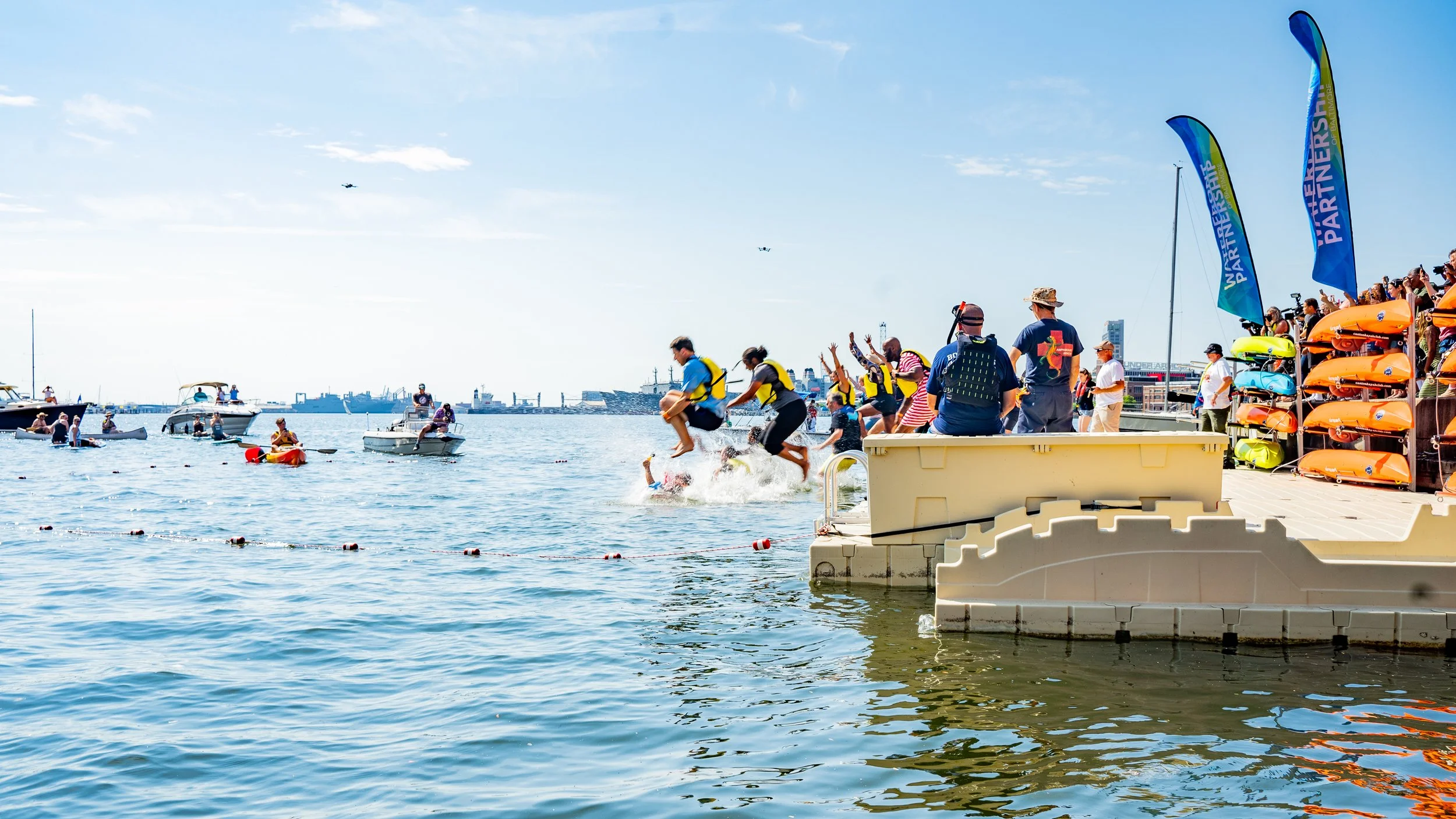Why We Canceled Harbor Splash- and What’s Next for Urban Swimming in Baltimore
This morning, we made the difficult decision to cancel Harbor Splash 2025. We know this news will disappoint many of you—it disappoints us too. Swimming in the Baltimore Harbor is a unique and joyful experience, and it’s at the heart of our vision for a healthier, more connected city. The good news? Our commitment to making Baltimore a swimmable city hasn’t changed. In fact, we’re doubling down.
Why did we cancel Harbor Splash?
The short answer: rain.
Rainfall washes pollutants off streets, rooftops, and other hard surfaces into local waterways. These pollutants temporarily impact water quality, making swimming unsafe for up to 48 hours after a storm. It’s an issue faced by cities everywhere, not just Baltimore. Earlier this year, the Maryland Freedom Swim across the Choptank River was also canceled for the same reason.
Even Paris, which made international headlines by opening three swimming areas on the Seine for the first time in 100 years, faced similar challenges. The day after their pools opened, rain forced an immediate closure. They’ve since reopened, but the lesson is clear: rain complicates urban swimming everywhere.
Baltimore and the Global Swimmable Cities Movement
Despite this setback, Baltimore is part of a growing global movement to reclaim city waterways for people. Last month, Waterfront Partnership staff attended the first-ever Swimmable Cities Summit, held in our sister city, Rotterdam. Over 200 leaders from 70 cities and 20 countries came together to share strategies and successes.
The event kicked off with Baltimore’s own Katie Pumphrey swimming into Rotterdam’s city center alongside Olympic open-water swimmer Toby Robinson. They were greeted by cheering crowds and participants leaping into Rijnhaven Harbor, a post-industrial basin now transformed into a floating park and public swim spot.
The summit was inspiring, but also practical. Here are our three biggest takeaways:
1. The Baltimore Harbor Is More Swimmable Than We Think
Urban swimming is never simple, but Baltimore has advantages many cities don’t.
The Harbor routinely meets the EPA’s swimming standards, which are strict compared to international standards, so long as it hasn’t rained within 48 hours.
Our waterfront promenade offers ample public access.
It is perfectly legal to swim in the Baltimore Harbor.
Compare that to New York City, where +POOL had to change state laws and create new permitting systems just to plan for swimming. Paris had to alter shipping schedules to stop barge traffic during swim hours. Washington, DC? It’s still illegal to swim in the Potomac.
Baltimore is closer than we think—we just need to plan for it.
2. We Need to Build a Culture of Urban Swimming
This summer, Baltimore celebrated the opening of three new public pools—a great step. But if we want to make urban swimming part of city life, we need more than pools.
In Rotterdam, a floating park was built in a post-industrial harbor basin. They even retrofitted a canal for surfing. So, what’s next for Baltimore?
Baltimore should sign the Swimmable Cities Charter to align with the global movement and affirm the right to swim in safe, healthy waterways.
Conduct a feasibility study to identify prime locations in the Inner Harbor and Middle Branch for public swimming. Could we create a beach? A floating park? Initial Harborplace renderings showed a wave pool—how do we get there?
Plan more flexible swim events. Because rain can cancel big events, let’s host pop-up swim days when conditions are right. Let’s launch an Inner Harbor swim club, explore cold-water therapy events, and invite Swim Across America to bring their annual charity swim to Baltimore.
3. Swimming Should Be Free and Accessible
Access to safe, swimmable water should be a basic right, not a luxury. Special events can have entry fees, but the simple act of swimming should remain free and open to everyone.
Public swim sites should include basic amenities—ladders, public showers, bathrooms—and be designed for everyone to enjoy, regardless of income or zip code.
What’s Next?
Canceling Harbor Splash doesn’t mean giving up, it means thinking bigger. Cities around the world are proving it’s possible to bring swimming back to urban waterways. Baltimore has the access, the energy, and the will to lead this movement in the U.S.






